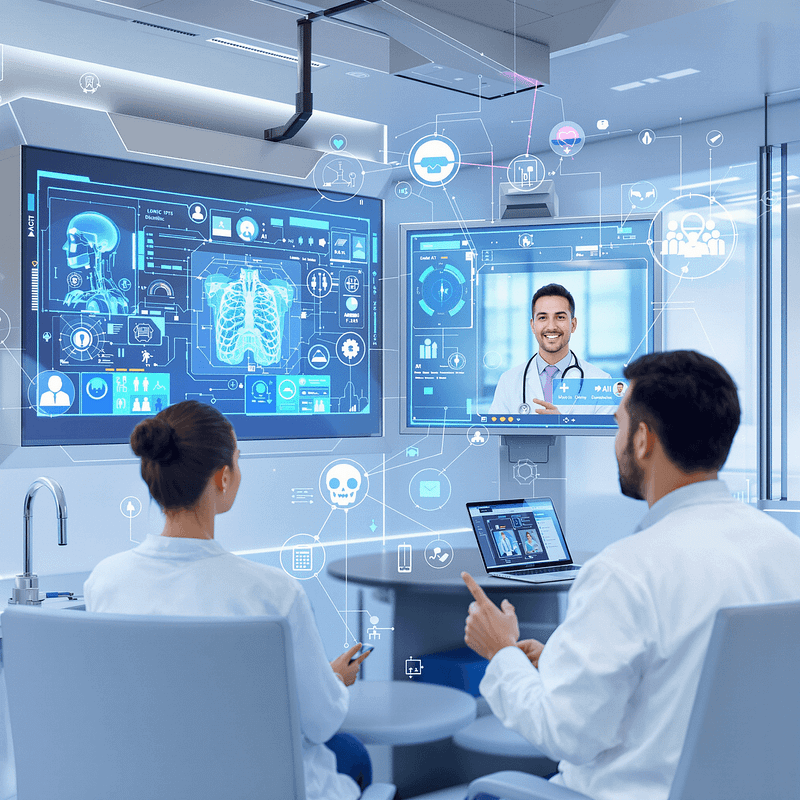NEW TECHNOLOGIES
Revolutioning the future

Technology is having a radical impact on our world. New technologies such as AI-driven health care applications and sophisticated security technology are changing practically all facets of human existence. Everything is digitized, from the way you get medical care to how you travel through airports to how you interact with people around the globe.
The implications of these wide-spread technological advances impact industries of all types including the following:
Improved Healthcare Delivery: AI diagnostics and telemedicine services are transforming how patient care is delivered.
Improved Security: Smart surveillance and biometric identification systems are protecting people and assets.
Increased Connectivity: 5G technology is providing analysis and real-time data processing and rapid long-range communication.
Increased Efficiency: Automated systems are improving manufacturing and service delivery including automation and robotics.
The convergence of these technologies is laying the foundation for a safer, faster, more efficient and more connected future.
Technologies will continue to evolve quickly, and as we enter a new era of digital solutions and applications across all aspects of every day living, the future appears bright.
1. Healthcare Innovations
Technology has brought about significant changes in the healthcare industry. Here are some of the key innovations that are making a difference:
AI-Powered Diagnostics
AI diagnostic systems are now analyzing medical imaging at an unprecedented level of accuracy, detecting diseases such as cancer and heart disease in their earliest stages. Current systems can take in vast amounts of patient data in minutes, allowing for faster and more accurate diagnoses.
Telemedicine
Telemedicine platforms have revolutionized access to health care services. You can communicate with healthcare providers through secure video consultations, get a prescription, and receive health care advice more simply than ever, from your home. This is particularly useful for:
Patients in rural locations
Individuals with limited mobility
Regular follow-up appointments
Consultations for mental health issues.
Wearable Health Devices
Wearable health monitors are changing the way we do preventive care by measuring things like:
Heart rate and blood pressure
Sleep
Activity levels
Blood glucose levels
These devices also give patients and health care providers real time health data to allow for better intervention before a serious situation occurs. As well as improve the personalization of a treatment plan.
Virtual Reality in Rehabilitation
Virtual reality-assisted rehabilitation has revolutionized the world of physical therapy. Patients participated in exercises in a virtual world and could be specifically focused on their needs, tracking and adjusting their progress in real-time. This technology has yielded very successful results in:
stroke recovery
sports injury rehabilitation
balance and coordination training
pain management programs
The combination of these technologies represents a powerful new use of resources in healthcare. Not only have they reduced wait time and improved staff utilization from a physical space, but they have also improved patient outcomes.
2. Airport Security Advancements
The improvement of security at airports has been drastically transformed with the use of AI and biometric systems. Today’s airports utilize cutting-edge facial recognition and iris scanning technologies to confirm passenger identities in seconds. It is reported that these technologies can scan thousands of travelers in record time and maintain an accuracy rate of 99.9%!!
Key Security Innovations:
- High resolution CT scanners produce 3D images of luggage contents
AI-powered threat detection systems recognize suspicious behavior patterns
Biometric gates automate passport control and boarding
Smart cameras recognize when passengers are moving through the terminal - Capabilities like these have reduced the security checkpoint wait time by as much as 60%. Now passengers move through screening processes without removing electronics or liquids from their carry-on bags, making for a more ‘hassle-free’ travel experience.
Privacy Considerations:
- Data encryption protocols protect sensitive biometric data
Strict access controls narrow who can view passenger data
Regular security audits guarantee compliance with existing privacy protocols - Cost of adopting security measures challenges airports with lower passenger volumes. A biometric security system costs on average $500,000 and requires substantial investment. Integrating a biometric system into existing infrastructure requires planning and staged deployment to minimize it impact on transit service schedules.
These technologies placed airports at the cutting edge of security, weighing enhanced protection with functional capacity.
3. The Impact of 5G and AI Convergence on Industries
The synergy of AI and 5G offers a potentially transformative environment across a wide range of industries: The twin combination takes businesses from outdated modes of operation to smart business automation systems that integrate real-time decision-making capability.
4. Global Investments in Technological Advancements Despite Challenges
Investment in 5G networks and AI technologies continues to rise globally and is projected to reach $900 billion by 2025. Interestingly, the increase does not reflect the significant implementation challenges that organizations continue to face globally.
The major challenges include:
High Infrastructure Costs: Initial costs for 5G networks, system upgrades and maintenance, training and developing specialized labor
Cybersecurity Vulnerabilities: Increased attack surface from the proliferation of IoT devices, concerns over data privacy, network breaching, etc.
Legacy Systems Integration: Compatibility with existing infrastructure, gradual transition, risk of operational interruption
Organizations are finding creative ways to mitigate these challenges. Cloud-based options lower the cost of initial infrastructure while pay-as-you-grow options allow for scalable implementations. Security options that include AI-powered threat detection and zero-trust architectures help minimize risk in storing sensitive data.


Comments
Post a Comment